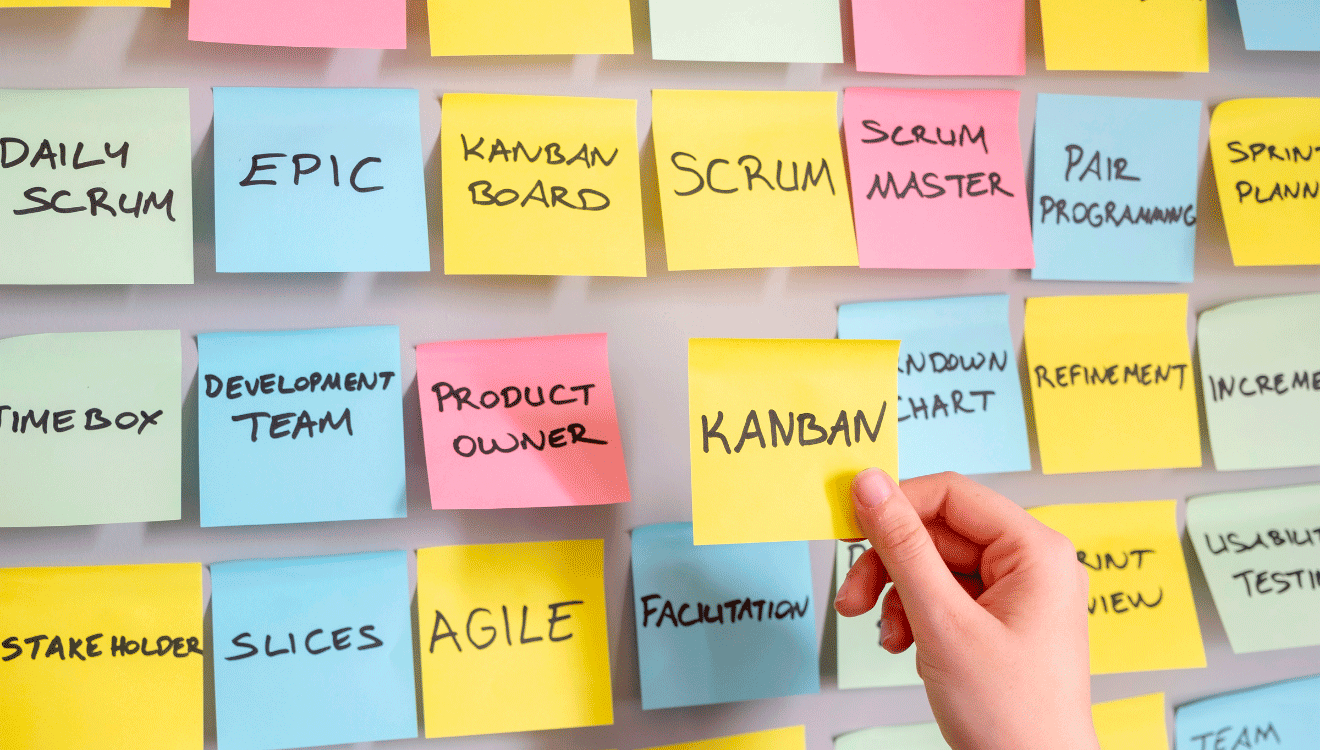In this article
- 1 What does Agile Management mean?
- 2 What are the Agile methodologies?
- 3 Benefits and Challenges of Agile Management
- 4 What are the 12 Principles of the Agile Methodology?
- 5 How to Implement Agile Management in Your Company
- 6 Agile Dictionary: Basic Concepts
- 7 Platforms and Tools Adapted to Agile Methodology
In a constantly changing and evolving business world, Agile Management has become an increasingly recurring term. But do you really know what Agile Management means, or is it just a buzzword?
Don’t worry, in this article, we will delve deep into the world of Agile Management, the most popular methodologies, and how to implement this working philosophy in your company.
- 1 What does Agile Management mean?
- 2 What are the Agile methodologies?
- 3 Benefits and Challenges of Agile Management
- 4 What are the 12 Principles of the Agile Methodology?
- 5 How to Implement Agile Management in Your Company
- 6 Agile Dictionary: Basic Concepts
- 7 Platforms and Tools Adapted to Agile Methodology
What does Agile Management mean?
Agile Management is a philosophy and management approach that focuses on flexibility, collaboration, and adaptability. It is based on the premise that, in a constantly changing business environment, companies need to be agile and capable of responding quickly to market and customer needs.
Agile Management moves away from traditional and bureaucratic approaches in favor of self-organized interdisciplinary teams that work in short cycles and deliver value continuously.
What are the Agile methodologies?
There are several widely used Agile methodologies, each with its own characteristics and approaches. Some of the most popular ones include:
Scrum
Scrum is an Agile methodology that promotes teamwork and focuses on dividing work into sprints, daily meetings, and continuous adaptation. It requires constant inspection to identify what is going wrong in the process and take timely action to adapt to those changes.
Kanban
The Kanban methodology focuses on visualizing workflow and limiting work in progress. This methodology is represented through a card-based board divided into columns that indicate the status of a project or task.
These cards describe the task to be performed, the estimated time to complete it, and the name of the employee responsible for it. And most importantly, they cannot overlap, meaning that until one task (card) is completed, you cannot move on to working on the next one.
Extreme Programming (XP)
XP stands out for its emphasis on software excellence and close collaboration among team members. To give you an idea, XP is designed to deliver the software that users require at the right moment, enabling developers to agilely adapt to changing customer demands.
Agile Inception
Agile Inception focuses on preparation and organization before starting an Agile project. It aims to leverage the expertise of individuals from different areas of the company and achieve a shared vision.
Design Sprint
Design Sprint, developed by Google, focuses on ideation, prototyping, and rapid testing of concepts. It blends agile methodologies with design thinking and completes the sprint steps in 4 days. It is recommended for initiating a project’s focus rather than using it as a full working process.
Benefits and Challenges of Agile Management
Agile Management stands out for its adaptability, quality, and collaboration in project management. Its focus on the continuous delivery of value to the customer, the ability to quickly adjust to changing requirements, and the promotion of high-quality development are its main strengths. Additionally, it fosters collaboration among teams and stakeholders to ensure a successful end product.
However, resistance to change and the need for a cultural shift can be obstacles, and it is essential to address them through clear communication, appropriate training, and a shared vision. To successfully implement Agile Management, organizations must overcome these challenges and focus on education, promoting an agile mindset, and investing in proper training and leadership.
What are the 12 Principles of the Agile Methodology?
- Prioritize customer satisfaction through continuous delivery.
- Welcome changes in requirements, even late in the project.
- Deliver functional software frequently.
- Collaborate with customers and team members throughout the project.
- Build projects around motivated individuals.
- Use face-to-face communication as the primary means.
- Measure progress primarily through functional software.
- Maintain a sustainable work pace.
- Pursue technical excellence and good design.
- Keep things simple and focus on the essentials.
- Self-organizing teams make decisions.
- Reflect regularly and adjust the approach accordingly.
How to Implement Agile Management in Your Company
Suitability Assessment
Before implementing Agile Management, assess whether it is suitable for your company and your projects.
Building the Perfect Team
Select team members who are committed, collaborative, and willing to learn.
Training and Gamification
Provide training and use gamification approaches to engage your team.
Design Agile Processes, Boards, and Tools
Adapt your processes and use tools like Kanban boards and boards to manage the work.
Establishing KPIs – What, How, and Why We Measure
Define key performance indicators to assess success and continuous improvement.
Gradual Implementation and Continuous Improvement
Introduce Agile Management gradually and adjust the approach as you learn and evolve.
Agile Dictionary: Basic Concepts
- Sprint: A fixed period of time during which work is done in a Scrum project.
- Kaizen: Japanese philosophy of continuous improvement.
- Daily Standup: Daily tracking meeting in Scrum.
- Backlog: List of pending tasks in an Agile project.
- User Story: Description of functionality from the user’s perspective.
- Burn-down Chart: Graph showing the remaining work in a project.
- Kanban Board: Visual board displaying workflow in Kanban.
- Pair Programming: Practice of programming in pairs to improve code quality.
You may be interested
Platforms and Tools Adapted to Agile Methodology
- Trello: A project management tool that uses Kanban boards to visualize work.
- Taiga: An Agile project management platform that offers tracking and collaboration features.
- Asana: A task and project management tool that enables collaboration in Agile teams.
- Jira: A software development platform that provides project tracking and issue management, widely used in Agile environments.
If you’re looking for an inspiring and fully equipped environment to carry out these Agile methodologies, don’t miss our offer of meeting rooms in Madrid and Barcelona. In our flexible spaces, you’ll have the perfect atmosphere for collaboration and innovation, with its modern and functional design that fosters creativity and productivity. Furthermore, we provide cutting-edge technology and other amenities to efficiently and effectively achieve any goal.
Whether it’s for Scrum, Kanban, or other Agile practices, our meeting rooms offer the right environment to drive the success of your project. 🚀


